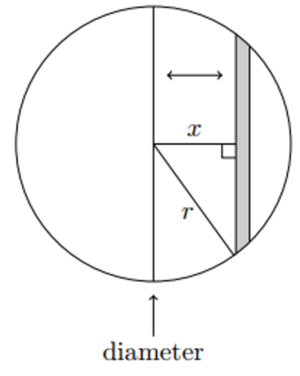Science:Math Exam Resources/Courses/MATH103/April 2017/Question 05
{{#incat:MER QGQ flag|{{#incat:MER QGH flag|{{#incat:MER QGS flag|}}}}}}
• Q1 (a) • Q1 (b) • Q1 (c) • Q1 (d) • Q1 (e) (i) • Q1 (e) (ii) • Q1 (e) (iii) • Q1 (f) • Q2 (a) • Q2 (b) (i) • Q2 (b) (ii) • Q2 (c) • Q3 (a) • Q3 (b) • Q3 (c) • Q3 (d) • Q4 • Q5 • Q6 (a) • Q6 (b) • Q7 (a) • Q7 (b) • Q7 (c) • Q8 (a) • Q8 (b) • Q8 (c) • Q9 (a) • Q9 (b) • Q9 (c) • Q9 (d) • Q9 (e) •
Question 05 |
|---|
|
In a petri dish with a radius of scientists placed a bacteria killing agent along a diameter. They found the density of bacteria, , increased with distance cm from the diameter according to for some constant . Determine the total population size of bacteria, , in the petri dish. |
|
Make sure you understand the problem fully: What is the question asking you to do? Are there specific conditions or constraints that you should take note of? How will you know if your answer is correct from your work only? Can you rephrase the question in your own words in a way that makes sense to you? |
|
If you are stuck, check the hint below. Consider it for a while. Does it give you a new idea on how to approach the problem? If so, try it! |
Hint |
|---|
|
As the density of bacteria is given for any point on petri dish, estimate the population of bacteria on the grey strip illustrated in the question. Use this to set up the integral that determines the entire population (the quantity ), but do this with care as some functions are only antiderivatives on certain intervals. |
|
Checking a solution serves two purposes: helping you if, after having used the hint, you still are stuck on the problem; or if you have solved the problem and would like to check your work.
|
Solution |
|---|
|
To estimate the number of bacteria in the shaded area, recall that the length of the grey strip in the petri dish that is a distance of from the diameter is, by Pythagoras' theorem, . Since the width of the shaded area is , and because , the number of bacteria in the grey strip is the product
Moreover, as , the number of bacteria to the right of the diameter equals to the number of bacteria to the left of the diameter. So as is the collection of the bacteria from all such grey strips, the number of bacteria to the right of the diameter is
Use integration by substitution with the substitution to obtain
So, as is an antiderivative of on , the Fundamental Theorem of Calculus gives
And it follows that
Hence, the total population of the bacteria is |
{{#incat:MER CT flag||
}}


















![{\displaystyle [0,3]}](https://wiki.ubc.ca/api/rest_v1/media/math/render/svg/d5c9e70f7d437509d4ebedb0eaf7ada946e91a79)



